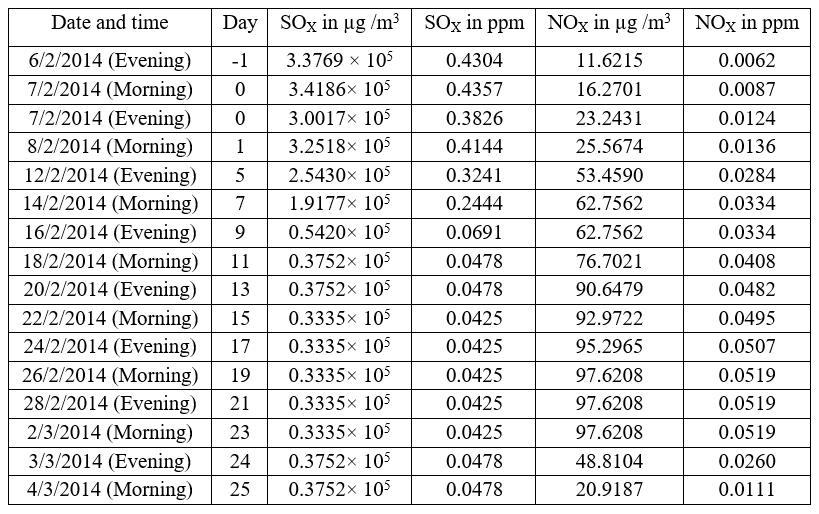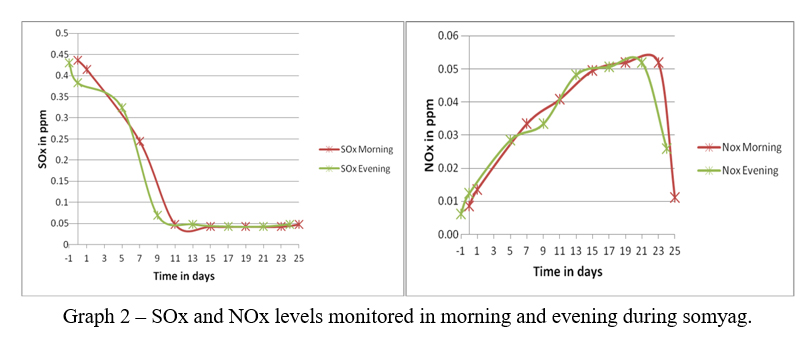Study the effects of Yadnya fumes on SOx and NOx levels in the surrounding environment
by
Abhang Pranay, D. Pathade Girish
Teaching Associate, Institute of Bioinformatics and Biotechnology, Savitribai Phule Pune University, Pune 411007, Maharashtra, India1
Principal, H. V. Desai College, Pune 411002, Maharashtra, India 2
Email – pranayabhang@yahoo.co.in, Email – girishpathade@yahoo.co.in

ABSTRACT
Yadnya is a ritual of offerings accompanied by chanting of Vedic mantras derived from the practice in Vedic times. Due to Yadnya fumes and overall process, it affects environmental elements, hence its effects on oxides of sulphur and nitrogen were studied as they are the major air pollutants. Effects of Agnihotra Yadnya, Shrisukta Yadnya, and somyag Yadnya were studied by collecting surrounding air using a handy sampler. SOx and NOx levels before Yadnya, during Yadnya and after Yadnya were calculated and compared from collected air. As per our results, SOx levels decreases up to 10 times (almost reduces to 90%) that of initial levels due to all three Yadnyas. NOx levels increase 10 -20 % that of initial levels, but at the end of all Yadnyas NOx level reduces that to initial. Hence by performing Yadnya SOx and NOx pollution can be controlled.
INTRODUCTION
Agnihotra Yadnya, Shrisukta Yadnya, Somyag Yadnya are rituals of offerings of ghee, dried twigs of various plants that are religiously mentioned in the Vedic literature and have medicinal potential, as well accompanied by chanting of Vedic mantras derived from the practice in Vedic times. These Yadnyas are performed by using the method mentioned in the Vedic literature.
In the air as a part of pollution, various pollutants are found especially Sox and NOx. There are claims that Yadnya fumes and procedures reduce air pollutions. Hence attempts were made to test scientifically the effect of Yadnya fumes and procedure on the levels of Sox and NOx.
METHOD
Air samples were collected by using respective absorbing reagents for SOx and NOx with the help of Handy sampler. (Spectralab, HDS -8)
A. Estimation of SOx
SOx was estimated by improved West and Gaeke method (1956), in short, SO2 from the surrounding airstream was absorbed in a sodium tetra-chloromercurate solution, it forms a stable dichloro sulpho mercurate (HgCl2SO3)2- complex, which then behaves effectively as fixed SO3-2 in solution. The amount of SO2 was then estimated by the color produced when p-rosailine-hydrochloride and formaldehyde were added in solution, which can be measured on a spectrophotometer at 560 nm. Calibration curve of standard sodium meta-bi sulphate was used for SOx estimation by using the following formula

B. Estimation of NOx
NOx was estimated by modified Jacobs – Hochheiser method (1972), in short, NO2 in air was collected by scrubbing a known volume of air through an alkaline solution of arsenite. The nitrite ions thus formed was reacted with sulfanilamide and N-(1-naphthyl) ethylenediamine (NEDA) in phosphoric acid to form the colored azo dye, which can be measured on spectrophotometer at 540 nm. The method was standardized statistically by using NaNO2 standards. Standardization is based upon the empirical observation that 0.74 mole of NaNO2 produces same color as 1 mole of NO2. SO2 can be removed using H2O2.

RESULTS
1. Agnihotra yadnya performed at Biotechnology department of Fergusson College, Pune

Table 1 – Effect of Agnihotra yadnya (Fergusson College) on SOx and NOx levels.
SO2 level in atmosphere reduces from 1.44 ppm to 0.56 ppm (about 43%) due to Agnihotra fumes (performed at sunset). NO2 level in the surrounding atmosphere was increased from 0.0086 ppm to 0.0094 ppm due to Agnihotra fumes (performed at sunset).
2. Agnihotra yadnya performed at Ramanbaug High-school, Pune

Table 2 – Effect of Agnihotra yadnya (Ramanbaug High-school) on SOx and NOx levels.
SOx in the surrounding environment reduces up to 10 times (4.4729 ppm to 0.4758 ppm) due to Agnihotra fumes. The effect of fumes remains after Agnihotra also, SOx shows 10 times reduction (Performed at sunrise). NOx in the surrounding environment increases up to 0.001 ppm due to Agnihotra fumes. But at the end of the Agnihotra NOx level become normal as before Agnihotra.
3. Shree-sukta Yadnya performed at Biotechnology department of Fergusson College, Pune

Table 3 – Effect of shreesukta Yadnya on SOx and NOx levels.
As per results, SO2 in the surrounding environment decreases 10 times (6.29 ppm to 0.65 ppm) due to the fumes of yadnya, NO2 level in environment increases (from 0.0034 ppm to
0.0046 ppm) but there is no any drastic change in NO2 level.
4. Somyag yadnya performed at Beed

Table 4 – Effect of somyag Yadnya (Beed) on SOx and NOx levels.
SO2 level in atmosphere reduces from 0.175 ppm to 0.0175 ppm (10 times) due to Mahasomyag fumes. There is no significant effect of Mahasomyag fumes on NO2 concentration. There is slight increase (0.0008 ppm) in NOx levels i.e. from 0.00094 ppm to 0.00173 ppm.
5. Somyag yadnya performed at Uruli (Devachi), Pune

Table 5 – Effect of somyag Yadnya (Pune) on SOx and NOx levels


SOx level decreases during and after yadnya up to 10 times that of initial (Reduces from 0.43 ppm to 0.048 ppm). SOx level remains decreased after the yadnya (at least up to 2 days) was finished. SOx pollution in the air can be reduce up to 90% by performing yadnya.
NOx level increases during yadnya up to 0.05 ppm, but also decreases to normal level (0.01 ppm) after yadnya (on day 24 and 25).
NOx level increases up to 20% as compare to initial (day -1 and 0) NOx levels. Standard NOx
(mostly NO2) level provided by ‘National Ambient Air Quality Standards’ (NAAQS) as well as ‘Maharashtra Pollution Control Board’ is 0.053 ppm (annual average per hour). Maximum value recorded was 0.052 ppm (during day 19 to 23) which is less as compare to standard levels.
REFERENCES
- W. West and G. C. Gaeke. “Fixation of Sulfur Dioxide as Disulfitomercurate (II) and Subsequent Colorimetric Estimation”. Anal. Chem., 1956, 28 (12), pp 1816 – 19.
J.H. Blacker and R.S. Brief. “Evaluation of the Jacobs-Hochheiser method for determining ambient nitrogen dioxide concentrations”. Chemosphere, volume 1, issue 1, January 1972, pp 43 – 6.
Pathade G. and Abhang Pranay. “Scientific study of Vedic knowledge – Agnihotra”, Bharatiya Bouddhik Sampada, quarterly Science Journal of Vijnana Bharati, Issue No. 43 – 44, Feb – June 2014, pp 18 – 27.
